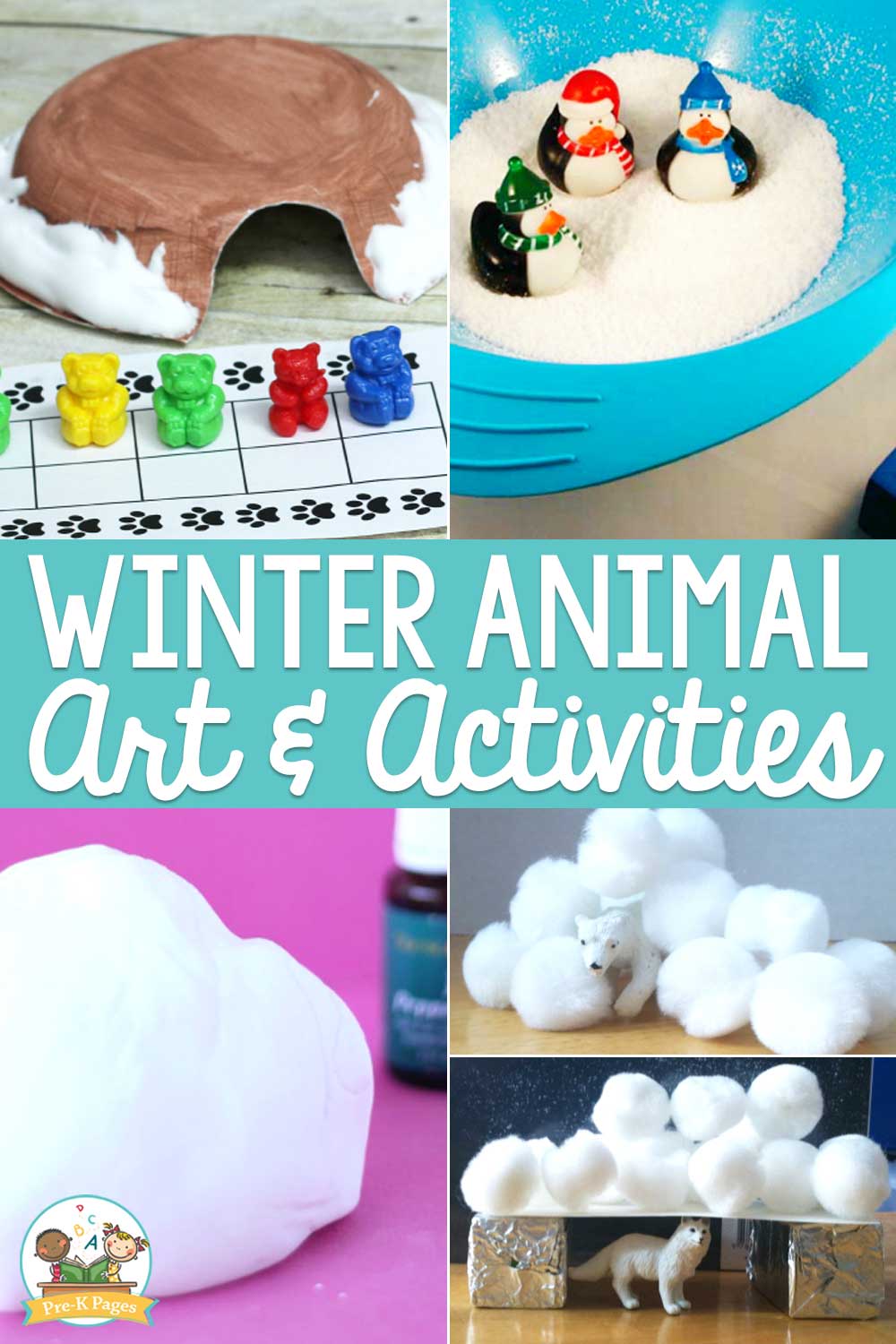Preschool Winter Animals Theme introduces children to various animals that are active during the winter season. This theme helps children learn about animals’ behavior and adaptations in cold weather.
As winter arrives, preschoolers can explore how animals survive in the snow and cold temperatures. This theme offers a hands-on approach to teach young children about hibernation, migration, and other winter survival strategies of animals. Engaging activities such as crafts, storytelling, and outdoor exploration can foster children’s curiosity about winter animals.
Through this theme, preschoolers develop an understanding and appreciation for the wildlife that thrives in the winter months. By incorporating fun and educational experiences, educators can enhance children’s knowledge of the natural world while promoting empathy and respect for winter animals.
Planning A Winter Animals Theme
Introducing The Winter Animals Theme
Introducing the Winter Animals theme to preschoolers is an exciting way to engage them in the wonders of winter and the diverse world of animals. This theme offers a perfect opportunity for children to explore the habitats and characteristics of various winter animals, fostering their curiosity and love for nature.
Choosing Suitable Winter Animal Crafts
When selecting winter animal crafts for the theme, it’s crucial to consider activities that cater to different skill levels and keep children engaged. From creating snowflake penguins to crafting polar bear masks, incorporating a variety of crafts will ignite creativity and imagination among the preschoolers. Providing a diverse range of crafts ensures that every child can find an activity they enjoy while learning about winter animals.
Selecting Winter Animal Story Time Picks
Storytime is an essential component of the Winter Animals theme as it allows children to connect with the animal characters and their winter adventures. Choosing winter animal-themed books with captivating illustrations and relatable stories can captivate young minds, encouraging a deeper understanding and appreciation of the fascinating creatures that thrive during the winter season.
Sensory Play With Winter Animals
Incorporating sensory play into preschool activities is a fantastic way to engage young learners and encourage their natural curiosity. With a winter animals theme, sensory play takes on a new level of excitement as children explore the textures, sounds, and movements associated with these fascinating creatures. Here, we’ll delve into some creative and educational sensory play ideas for preschoolers, centered around the enchanting world of winter animals.
Exploring Winter Animal Sensory Bins
Sensory bins are a popular tool for engaging children in hands-on exploration. Winter animal sensory bins can be created using materials such as fake snow, pinecones, animal figurines, and textured fabrics. Children will enjoy digging through the bins, feeling the different textures, and using their imagination to create stories and scenarios with the animal figures.
Creating A Winter Animals Ice Play Station
An exciting sensory experience for preschoolers is creating an ice play station with a winter animals theme. Fill a large container with water, add in some winter animal toys, and freeze it overnight. The next day, provide tools such as salt, water droppers, and toy hammers for the children to extract the animals from the ice. This activity not only engages their senses but also teaches them about the properties of ice and the concept of melting.
Incorporating Winter Animal Playdough Fun
Playdough is a versatile sensory material that lends itself well to a winter animals theme. Create a playdough station with textures and scents that resemble the winter environment, such as adding glitter for snow, and essential oils for a pine scent. Provide animal-shaped cookie cutters and encourage children to create their own winter animal scenes, fostering creativity and fine-motor skills.
Learning About Winter Animals
When it comes to teaching young children, a winter animals theme presents a wonderful opportunity to engage their curiosity and foster a love for the natural world. Learning about winter animals can be an exciting and educational experience for preschoolers. Through interactive activities and exploration, children can discover the unique adaptations of animals who thrive in cold climates. In this blog post, we will delve into the fascinating world of winter animals, focusing on understanding winter adaptations, exploring Arctic vs. Antarctic animals, and identifying hibernating animals. Let’s embark on an enriching journey to learn more about these amazing creatures!
Understanding Winter Adaptations
Winter adaptations refer to the special traits and behaviors that animals develop to survive in cold environments. These adaptations can include thick fur or blubber for insulation, hibernation to conserve energy, and unique hunting strategies to find food in snowy landscapes.
Exploring Arctic Vs. Antarctic Animals
Arctic and Antarctic animals have adapted to their respective polar environments in different ways. While both regions experience extreme cold, the types of animals and their adaptations vary significantly. Understanding the distinctions between these two ecosystems can provide valuable insights into the diversity of winter animal life.
Identifying Hibernating Animals
Hibernation is a survival strategy employed by many animals to cope with the scarcity of food and harsh conditions during the winter months. Preschoolers can learn to identify hibernating animals and understand the biological processes that allow them to enter a dormant state until the return of warmer weather.
Winter Animal Movement And Music
Explore the preschool winter animals theme with captivating activities that involve animal movement and music. Engage children in interactive experiences that promote learning about winter animals through playful movements and rhythmic sounds. Incorporate fun and educational elements into the classroom to make winter animal themes enjoyable for young learners.
Winter Animal Movement and Music When it comes to teaching preschoolers about winter animals, incorporating movement and music activities can be both fun and educational. Engaging in movement and music activities can help children learn about different winter animals’ movements and behaviors in an interactive and memorable way. Below are some exciting activities to incorporate into a preschool winter animals theme, under the subheading of Winter Animal Movement and Music.Dancing And Pretending To Be Winter Animals
Encourage children to dance and move like winter animals such as penguins, polar bears, and snow leopards. Use descriptive language to help them understand how each animal moves and encourage them to imitate these movements through dance. You can also organize a pretend play session where children can role-play as their favorite winter animals, incorporating creative movement and imaginative play.Singing Winter Animal Songs
Introduce children to fun and engaging songs about winter animals. Utilize songs that describe the movements and characteristics of animals such as “The Penguin Waddle” or “The Bear’s Snow Dance.” Singing along to these songs can help reinforce children’s understanding of how these animals move and behave in their natural habitats.Playing Winter Animal Movement Games
Incorporate interactive games that involve imitating the movements of different winter animals. Use game-based activities such as “Penguin Waddle Race,” where children waddle like penguins from one point to another, or “Polar Bear Tag,” where they mimic polar bear movements while playing a classic game of tag. By weaving these engaging activities into the preschool winter animals theme, children can develop a deeper understanding of winter animals’ movements and behaviors in an interactive and enjoyable manner.Culmination And Reflection
As the preschool Winter Animals theme comes to an end, it’s time to celebrate the creativity and learning that has taken place in the classroom. The culmination marks the opportunity to showcase the preschoolers’ winter animal creations, reflect on the theme, and celebrate the knowledge gained throughout the activities.
Showcasing Preschoolers’ Winter Animal Creations
The classroom is filled with excitement as the preschoolers’ winter animal creations take center stage. From intricately crafted paper mache penguins to snowflake-covered polar bears, the imagination and artistic talents of the little learners shine through. A table adorned with these masterpiece creations adds a touch of spectacle to the atmosphere.
Reflecting On The Winter Animals Theme
As the theme draws to a close, it’s essential to reflect on the journey of exploration and discovery taken by the preschoolers. Reflecting on the Winter Animals theme brings to light the new knowledge gained about different winter animals, their habitats, and behaviors. The reflective process allows both educators and children to consolidate their learnings and appreciate the variety of experiences that shaped the theme.
Celebrating Winter Animals With A Classroom Winter Wonderland
To wrap up the Winter Animals theme in grandeur, the classroom transforms into a Winter Wonderland. Sparkling snowflakes, dangling icicles, and a cozy arctic backdrop set the scene for a vibrant celebration. The classroom becomes an immersive environment, creating an atmosphere of joy and accomplishment, marking the end of a successful theme.

Credit: www.pinterest.com
Frequently Asked Questions Of Preschool Winter Animals Theme
What Are Some Fun Animal-themed Activities For Preschoolers In Winter?
Engage preschoolers with crafts like penguin art, bear dens, and snowflake activities. Teach them about hibernation and winter animal habitats with sensory bins and role-playing games. These activities encourage learning about animals while having fun in the winter season.
What Educational Benefits Can Children Gain From A Winter Animals Theme?
Exploring the winter animals theme helps children learn about adaptation, hibernation, and migration. It enhances their understanding of ecosystems, animal behavior, and winter survival strategies. Through hands-on activities, children develop scientific thinking, observation skills, and empathy towards animals in their natural habitats.
How Can A Winter Animals Theme Be Integrated Into Different Areas Of Study?
Integrate the winter animals theme into literacy by reading books, creating stories, and practicing handwriting. In science, explore animal adaptations and seasonal changes. Math activities can involve counting, sorting, and measuring animal footprints. Art and music can also incorporate the theme through coloring, singing, and imaginative play.
What Are Some Recommended Books And Resources For A Preschool Winter Animals Theme?
Books like “The Mitten” by Jan Brett and “Over and Under the Snow” by Kate Messner are popular choices. Online resources, such as printable animal fact sheets and educational videos, provide additional support for teaching about winter animals. These materials offer diverse perspectives on animals’ winter behavior and adaptation strategies.
Conclusion
A preschool winter animals theme provides an enriching and engaging learning experience for young children. By incorporating various activities and crafts centered around winter animals, educators can encourage curiosity and creativity while fostering a deeper appreciation for nature. This theme offers an excellent opportunity for holistic development and joyful exploration.

